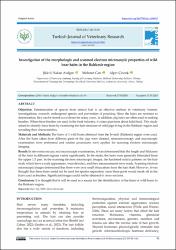| dc.contributor.author | Atalgın, Şükrü Hakan | |
| dc.contributor.author | Can, Mehmet | |
| dc.contributor.author | Çelenk, Alper | |
| dc.date.accessioned | 2024-02-05T15:58:15Z | |
| dc.date.available | 2024-02-05T15:58:15Z | |
| dc.date.issued | 2023 | |
| dc.identifier.issn | 2602-3695 | |
| dc.identifier.uri | https://doi.org/10.47748/tjvr.1298471 | |
| dc.identifier.uri | https://search.trdizin.gov.tr/yayin/detay/1208321 | |
| dc.identifier.uri | https://hdl.handle.net/20.500.12462/13892 | |
| dc.description.abstract | Objective: Determination of species from animal hair is an effective method in veterinary forensic investigations, research, endangered species and prevention of poaching. Since the bristles are resistant to deterioration, they can be stored as evidence for many years. In addition, pig bristles are often used in making brushes. When these brushes are used in the food industry, it raises questions about halal food. This study aimed to identify these hairs by examining the hair structure of wild pigs living in the Balıkesir region and revealing their characteristics. Materials and Methods: The bristles of 3 wild boars obtained from the İvrindi region were used. After the hairs taken from different parts of the pigs were cleaned, stereomicroscopy and macroscopic examination were performed and routine procedures were applied for scanning electron microscopic imaging. Result: In stereomicroscopy and macroscopic examination, it was determined that the length and thickness of the hairs in different regions varied significantly. In the study, the hairs were generally bifurcated from the upper 1/3 part. In the scanning electron microscopic images, the hardened cuticle patterns on the hair shaft, which have a scaly appearance, were detected, and their measurements were made. Scanning electron microscopic images determined that there were very small bifurcations from the hair shaft. However, it was thought that these bristles could not be used for species separation, since these parts would break off in the bristles used as brushes. Significant images could not be obtained in cross-sections. Conclusion: It is thought that it will be used as a source for the identification of the hairs of wild boars in the Balıkesir region. | en_US |
| dc.language.iso | eng | en_US |
| dc.relation.ispartof | Turkish Journal of Veterinary Research (Online) | en_US |
| dc.rights | info:eu-repo/semantics/openAccess | en_US |
| dc.rights | Attribution‐NonCommercial 3.0 United States | en_US |
| dc.rights.uri | http://creativecommons.org/licenses/by-nc/3.0/us/ | * |
| dc.subject | Hair | en_US |
| dc.subject | Pig | en_US |
| dc.subject | SEM | en_US |
| dc.subject | Stereo Microscope | en_US |
| dc.title | Investigation of the morphologic and scanned electron microscopic properties of wild boar bristles in the Balikesir region | en_US |
| dc.type | article | en_US |
| dc.contributor.department | Balıkesir Üniversitesi | en_US |
| dc.identifier.volume | 7 | en_US |
| dc.identifier.issue | 2 | en_US |
| dc.identifier.startpage | 91 | en_US |
| dc.identifier.endpage | 96 | en_US |
| dc.relation.publicationcategory | Makale - Ulusal Hakemli Dergi - Kurum Öğretim Elemanı | en_US |
| dc.buozel | trdizinideal | en_US] |
| dc.department-temp | Balıkesir Üniversitesi, Veteriner Fakültesi, Veteriner Anatomi Anabilim Dalı, Balıkesir, Türkiye Balıkesir Üniversitesi, Veteriner Fakültesi, Veteriner Anatomi Anabilim Dalı, Balıkesir, Türkiye Çukurova Üniversitesi, Veteriner Fakültesi, Histoloji ve Embriyoloji Anabilim Dalı, Adana, Türkiye | en_US |
| dc.identifier.trdizinid | 1208321 | en_US |
| dc.identifier.doi | 10.47748/tjvr.1298471 | |



















